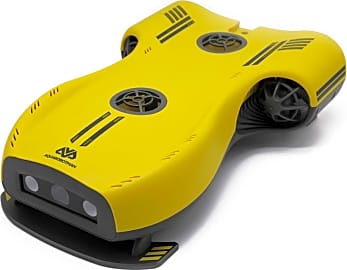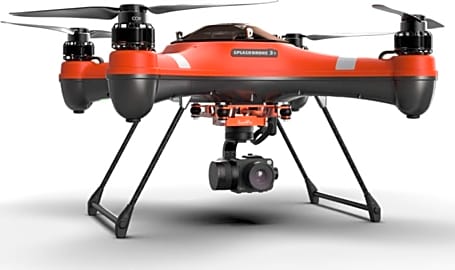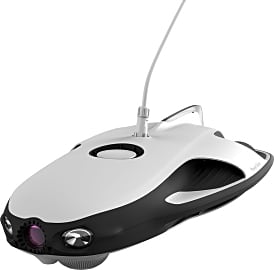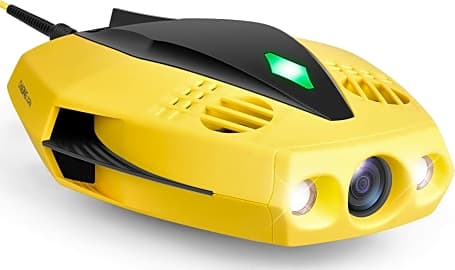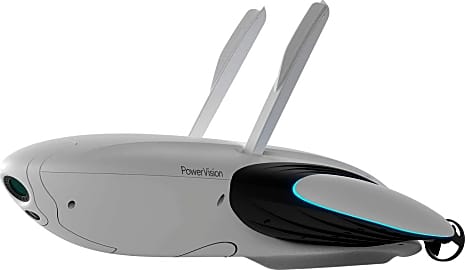The 7 Best Waterproof Drones

This wiki has been updated 34 times since it was first published in December of 2016. Whether you're showing off your UAV moves in inclement weather, hoping for a chance of recovery if your quadcopter lands in the drink, or trying to probe the depths for sea life, one of these waterproof drones could be what you need. Some are quite affordable, while many feature some advanced capabilities, but they all require you to follow all relevant laws and regulations in your location. When users buy our independently chosen editorial selections, we may earn commissions to help fund the Wiki.
Editor's Notes
August 29, 2020:
Unfortunately, the selection of waterproof drones on the market is rather limited, doubly so when trying to find models in the budget price range. After scouring the options, we have found what we believe are going to be the very best choices for most, though even these can often suffer from some reliability issues.
If you want a traditional quadcopter that flies, but one that can get wet and which is capable of taking high-quality footage, you'll be limited to the PowerVision PowerEgg X Wizard or the Swellpro SplashDrone 3+. The former is designed to take off and land on the ground or the water, thanks to having landing gear comprised of floating pontoons, and offers an impressive 30-minute flight time. It is also quite versatile because the camera detaches from the unit and doubles as a handheld or tripod-mountable recording device. The latter also boasts some impressive functionality, such as a lost drone beacon, the ability to fly in gusts up to 31 MPH, and a cruise mode that lets you yaw and fly the machine with a single joystick. Both are capable of recording 4k footage. If you need something budget friendly and don't care about high-end features or a camera, the JJRC H31 will fit the bill.
Those looking to explore the underwater environment, rather than the skies, can turn to the AquaRobotMan Nemo, Power Vision PowerRay Wizard, Chasing Dory, and PowerVision Powerdolphin. The first three are all submersible to depths of 328 feet, 100 feet, and 49 feet, respectively, while the last one is only designed to ride along the surface, but features a remote controllable camera that can be pointed downwards into the water. It also has sonar for underwater ground mapping. Unlike flying drones, which often have return home features, submersible ones have tethers to make sure they never get lost. Of these, the Chasing Dory is going to be the best for travelers due to its small size, but the AquaRobotMan Nemo and PowerVision Powerdolphin are both considerably more high tech when it comes to camera resolution and maneuvering capabilities.
August 06, 2019:
You might think there'd be more people manufacturing waterproof aerial drones, but the truth is that it's actually pretty difficult -- and expensive -- to put reliable seals on such small and fast-moving components as miniature rotors and camera gimbals. As it stands, for the average user who doesn't want to spend a ton of money but wants something they can fly in the rain, there's one device that stands out about the rest, and that's the JJRC H31. It's sold by a few different companies but they're all the same basic design. Make sure you install the rotor guards in order to protect the gear wells. The Q353 isn't quite as inexpensive, but it does have the ability to float on water, although its relatively meager construction may not actually be able to hold up to an unplanned and high-velocity water landing. It can switch relatively easily from boat to aerial mode, though.
If you're willing to spend considerably more, SwellPro makes two of the most capable and weather-resistant drones on the market, the Spry and the Splash Drone 3. The Spry is surprisingly compact and blazing fast, and has a ton of potential, though it costs as much as some high-end DJI drones. Their flagship, the Splash Drone 3, is a seriously top-of-the-line item, however it commands a very high price for their well-outfitted version, which is pretty restrictive for some people.
Then there are underwater drones, which are, as a rule, 100% waterproof. There are quite a few of these fledgling devices being released this year in particular, though it's a very niche market and we have yet to see more than a few credible reviews. A couple models that we have seen reliable testimony regarding are the Nemo and the PowerRay. But again, like the top SwellPro, they're both quite costly.
Check out the Special Honors section above to get an idea of the specialty drones offered that, while sometimes hard to get ahold of and sometimes requiring some DIY action, are very interesting choices.
Special Honors
DJI Matrice 200 If you've been flying drones for even a little while, you've probably heard of DJI. They're the current king of the small UAV world and their Phantom and Mavic lines are two of the most popular in the field's short history. The Matrice 200 is the only one they offer -- outside of a the multi-thousand-dollar agricultural sprayer Agras -- with reasonable water resistance. It's not cheap, but it is one heck of a piece of equipment. dji.com
QuadH2O Kit If you're not afraid to do a little engineering work on your own, check out this DIY kit. Truthfully, putting it together yourself may help you out in the long run, because if you use it around saltwater or extreme environments a lot, you'll likely end up having to repair it, despite its reasonable waterproofing. Nonetheless, it's an interesting kit and worth a look especially if you have a boat. quadh2o.com
Tetra TD-7 It has a sealed fiberglass body and accommodates some of the top cameras found in the skies today. We also can't tell you exactly how it will cost because each one is made to order, in the UK, starting from about 6,000 pounds sterling. It's exclusively marketed to professionals such as high-end photographers and search-and-rescue departments. It's also a seriously impressive piece of engineering. tetradrones.co.uk
Understanding Waterproof Designations
In the long term, flowing water can erode even the most robust landmasses, as evidenced by phenomena like the Grand Canyon.
For all its life-giving properties and its uses in cleaning, recreation, farming, and cooking, water has the potential to do an incredible amount of damage. In the long term, flowing water can erode even the most robust landmasses, as evidenced by phenomena like the Grand Canyon. On a smaller, more immediate level, water poses a significant threat to our modern electronics.
Electricity in any modern-day electronic device is very carefully directed, and even a small charge in the wrong place at the wrong time can irreparably destroy one or more vital components. Over time, the industry has developed techniques and treatments that can limit the amount that water can squeeze between cracks in a structure, as well as the degree to which that water can come into contact with an electrical charge.
As the science of waterproofing evolves alongside technological revolutions, the way we understand how and how well a given waterproofing system works requires a system. That system produces a lot of jargon that you’re liable to encounter any time you attempt to research a category of devices that are designed to get wet and keep performing. Understanding these designations and how they apply to certain types of gear or clothing will go a long way toward making your shopping experience run much more smoothly.
Waterproof ratings for electronics are typically represented by an ingress protection rating. IP ratings are often expressed with a pair of numbers, reading, for example, IP68, or IP46. The first number refers to physical egress by anything from a finger to a grain of sand or a particle of dust. The second number is the one with which we’re most concerned, as it regards the egress of water.
Waterproof ratings in the IP system range from zero to nine, with a few additional ratings in between numbers. It’d be wise to familiarize yourself with the list, but what’s most important for you to know is that the conditions under which many electronics items are tested are largely controlled by the manufacturer, so it’s wise to aim for the highest rating your budget will accommodate, even if it seems like overkill, as the results of these ratings might be somewhat embellished.
Which Waterproof Drone Is Right For You?
If you’re in the market for a waterproof drone, the odds are that you intend to fly it in areas where water is present. The big concern for you is what might happen to the drone if it falls from the sky and lands in a lake, a pond, or even a deep puddle.
If your controller or drone can interface with your smartphone or tablet, then you can continuously upgrade your screen as better devices come out over the years.
If the bodies of water over which you intend to fly are deeper than one meter, you’re going to want a waterproof rating of eight or higher, as the increased water pressure beyond one meter of depth will force water through the seals of less water-resistant aircraft. If you reserve your flying for clear days over solid ground, you can afford to save a little money on water resistance. It's also worth pointing out that a large percentage of drones aren't officially tested for ingress protection, and those that are legitimately waterproof and can truly withstand a dip in the drink can cost a considerable amount of money. In fact, most drones are so incredibly susceptible to moisture that even one marketed as water- or rain-resistant is worth a look, because a lot of them are remarkably fragile and can be fried by just a few drops of rain if you're unlucky.
From there, the same variables that would guide the purchase of any drone apply. The most important question centers on the unit’s intended use. A vast majority of drones are purchased for the purpose of attaining stunning aerial photography. If you fall into this camp, whether you’re more interested in video or stills, you’ll want to ensure that your selection has the highest-quality camera you can afford.
If you’re looking for a photography drone in particular, you’re going to want to investigate the way you control the camera. A dedicated screen built into the controller is convenient, but it can’t upgrade over time. If your controller or drone can interface with your smartphone or tablet, then you can continuously upgrade your screen as better devices come out over the years.
Other features to look out for include radio distance, a return-to-home function, and an automatic landing and shutoff feature that kicks in if you lose control to a dangerous degree. Many waterproof drones cease to be waterproof if you spin their rotors while they are in contact with water, so the ability for a unit to completely disengage after going down in a body of water could save the unit’s life.
A Brief History Of Drones
Drones can be rather difficult to control at first, and this is actually tied into their history. The earliest drones were developed by the Austrian military in the middle of the 19th century. These devices were merely large balloons that carried bombs across enemy lines. They proved relatively impossible to control, as shifting winds sent some of them back across the line of fire into Austrian territory.
Drone technology developed alongside advancements in flight through the beginning of the 20th century and into WWI.
Drone technology developed alongside advancements in flight through the beginning of the 20th century and into WWI. In WWII, the V-1 flying bombs caused a tremendous amount of damage in London.
The radio-controlled quadcopters that populate the vast majority of the commercial drone market developed from a model designed in the 1950s. For the majority of their existence, they were relegated to small clubs interested in racing and model technology.
More recently, the decreases in size and corresponding increases in quality coming out of the camera industry allowed drone operators to equip their flying vehicles with devices capable of capturing in-flight footage. This led manufacturers to install permanent cameras and camera mounts on many of their models. Meanwhile, the film industry began to use large, powerful drones outfitted with stabilizing gimbals and full-size film and digital cameras as a significantly less expensive alternative to the aerial shots that otherwise would have required a helicopter to capture.



